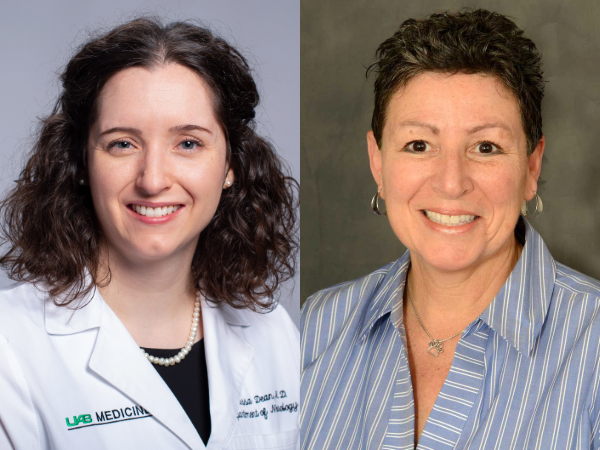 Tourette syndrome (TS) often begins in childhood, but for many patients, its challenges and care needs continue into adulthood. From early recognition and behavioral interventions to managing transitions and overcoming adult treatment barriers, TS demands a comprehensive, lifespan approach. At UAB, experts are addressing these needs through a collaborative model that supports patients from childhood through adulthood.
Tourette syndrome (TS) often begins in childhood, but for many patients, its challenges and care needs continue into adulthood. From early recognition and behavioral interventions to managing transitions and overcoming adult treatment barriers, TS demands a comprehensive, lifespan approach. At UAB, experts are addressing these needs through a collaborative model that supports patients from childhood through adulthood.
Marissa Dean, M.D., associate professor in the UAB Department of Neurology; Leon S. Dure, M.D., professor, William Bew White, Jr. Endowed Chair, and Director of the UAB Division of Pediatric Neurology in the Department of Pediatrics; Emily Gantz, D.O., assistant professor in the same division/department; Jan Rowe, Dr. OT, OTR/L, FAOTA, associate professor in the UAB Department of Occupational Therapy, and Co-Director of Children’s of Alabama/UAB Tourette Syndrome Center of Excellence; share their insights on Tourette syndrome and the transition from pediatric to adult care.
Early onset and diagnosis
TS typically begins between the ages of 4 and 7 and involves what are known as tics. Tics are sudden, rapid, repetitive, nonrhythmic movements or sounds that a person makes involuntarily. These often start subtly, such as blinking, eye rolling, sniffing, coughing, or throat clearing.
“It isn't unusual for a child to see an eye doctor or a pulmonologist before neurology is even considered,” Gantz said.
The diagnostic criteria for TS includes four components:
- The onset of tics must occur during childhood.
- There must be at least two motor tics.
- There must be at least one vocal tic.
- The tics must be present for more than a year—though not necessarily continuously.
Misunderstandings and parental concerns
When a child is diagnosed with TS, neurologists often encounter significant parental misunderstandings.
“Parents often think that a child must have a specific kind of tic, like yelling or shouting, to have TS,” Gantz explained. “They also sometimes believe it's caused by a concussion, an infection, or a medication. But TS is a genetic condition.”
A parent’s biggest concern, however, tends to be social.
“They fear their child will stand out, be made fun of, or be seen as different,” Gantz added. Helping families understand that tics are a form of normal movement is a central part of the early care process.
The UAB Pediatric Neurology Movement Disorders Clinic
The UAB Pediatric Neurology Movement Disorders Clinic at Children’s of Alabama has played a groundbreaking role in TS care, thanks to the leadership of Dure. Dure was one of the first pediatric neurologists to become fellowship-trained in movement disorders at the University of Michigan.
“That training, along with my own interest, motivated me to start the clinic,” Dure said.
Founded in 1994, the clinic quickly became a focal point for pediatric movement disorder care in the South.
 Marissa Dean, M.D. and Rowe, Dr. OT, OTR/L, FAOTA
Marissa Dean, M.D. and Rowe, Dr. OT, OTR/L, FAOTA
CBIT: a non-medication approach
One of the clinic’s most impactful initiatives has been the development of its Comprehensive Behavioral Intervention for Tics (CBIT) program. CBIT is a specialized therapy designed to help children learn strategies to suppress or manage their tics if they choose to do so.
“It’s not a cure,” Dure explained, “but it provides children with the tools to help them.”
“Because of our CBIT program, we have the unique opportunity to avoid the use of medications in many children with tics,” he continued. “CBIT is the first-line treatment for tics, if needed, and we’re lucky to have the program.”
Dure recalled the early days of the program’s development.
After the CBIT trial was published, he sought a psychologist to collaborate with but ultimately connected with Rowe, associate professor in the UAB Department of Occupational Therapy. “She became the first occupational therapist trained in the therapy and has since trained other OTs around the country. She now heads the CBIT clinic for children at Lakeshore,” he said.
Transition to adult care
While many children experience a significant reduction in tics over time, not all cases resolve by adolescence.
“Most often, tics improve with age, and many children outgrow them,” Gantz explained.
Because of this, the transition process is not routinely emphasized unless symptoms persist into adolescence or early adulthood. For some, TS continues into adulthood—often requiring a transition to adult care.
“In our clinic, our biggest role is making the correct diagnosis and educating the families,” she added. “We treat TS with CBIT, so we don’t typically use medications. That means we don’t follow these kids regularly after diagnosis. Instead, we equip them with information and encourage them to reach out if they ever want a referral for CBIT.”
Coordinating the transition
For patients whose TS symptoms persist into adolescence or adulthood, transitioning from pediatric to adult care can be a critical step in maintaining effective treatment.
“A smooth handoff from pediatric to adult care is essential,” Dean stated. “Our pediatric and adult movement disorders neurologists have a collaborative relationship.”
When the decision is made to transition to the adult clinic, prior records, including prior treatments for TS, are sent to the adult neurologist.
 Emily Gantz, D.O. and Leon S. Dure, M.D.Navigating adulthood with TS
Emily Gantz, D.O. and Leon S. Dure, M.D.Navigating adulthood with TS
When TS continues into adulthood, it often presents new challenges and requires a shift in care strategies. Dean emphasized the importance of building on what was learned during childhood.
“For adults who were diagnosed with TS as children, it is important to review treatments that were tried when they were a child and during adulthood,” she explained. “Identifying which treatments were effective in childhood can assist in planning treatment during adulthood.”
She also noted that co-occurring conditions, often present since childhood, play a key role in managing the disorder over time.
A shift toward medication-based care
Unlike in pediatric care, where CBIT is often the first line of treatment, adults with TS may find medication a more practical option.
“It is more challenging to coordinate non-medication treatment like CBIT due to busy work schedules and/or family obligations,” Dean explained. “That’s why medication-based treatments may be used more often when compared to the approach to treatment of childhood TS.”
Still, treatment needs vary.
“Generally, TS symptoms are most severe during childhood,” she added. “However, symptoms can vary over one’s lifespan. Therefore, effectiveness of treatments may change as someone ages.”
Access and care gaps
Unfortunately, gaps in care can emerge after patients leave pediatric services, especially when it comes to therapy access.
“The adult CBIT program is offered via telehealth for clients residing in Alabama,” Rowe explained. “Clients living in neighboring states may also participate if they are able to cross the Alabama state line, as our CBIT-trained occupational therapists can then provide virtual services.”
Dean followed by stating, “One of the biggest challenges that adult TS patients face is insurance coverage of CBIT. In addition to the time constraints adult patients have in trying to schedule CBIT with their busy schedules, coverage limitations remain a major barrier,.”
The UAB School of Health Professions (SHP), Department of Occupational Therapy, which offers adult CBIT services, currently does not have the infrastructure to bill insurance companies for CBIT. As a result, it is a self-pay program. However, scholarships are available for clients who are unable to pay out of pocket. In addition, the program follows a ‘pay-as-you-go’ model, allowing clients to pay per session rather than covering the full cost upfront.
Looking ahead, she hopes that will change.
“We would love to see the SHP be able to offer insurance billing to our clients,” she added, “so everyone who needs CBIT can benefit.”